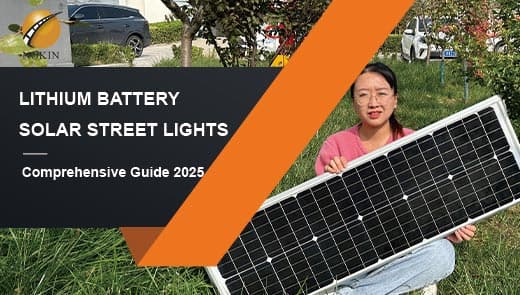How to Design Solar Street Lights for Desert Areas
Solar street lights are commonplace on city streets, and you may be used to them providing you with light at night. However, in the vast desert areas, where the natural environment is harsh and traditional electricity supply is difficult, how can lighting be realized at night?
With the popularization of solar street lights, desert solar street lights that can adapt to the desert environment also bring light to people in desert areas. In the application process of desert solar street light, the extreme climatic conditions and special geographic environment in the desert area, the design and performance of solar street light also put forward a serious challenge, how to make the solar street light perfectly adapted to the desert environment, and to maintain long-term stable and efficient operation, is a solar street light manufacturer is worth to explore the issue in depth.
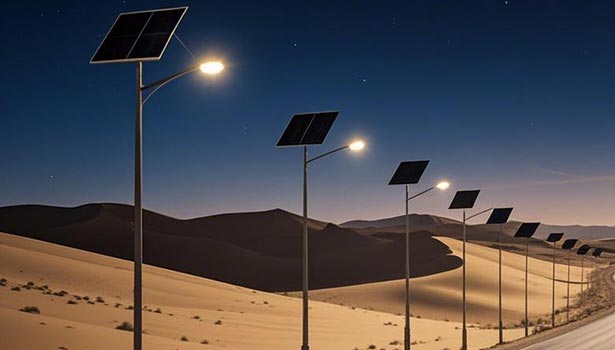
Special Environmental Factors in Desert Areas
Extreme Temperature Difference
One of the typical features of desert areas is the huge temperature difference between day and night. During the day, under the hot baking of the sun, the surface temperature can soar to 50℃ or even higher, but at night, when the sun goes down, the heat is rapidly lost, and the temperature will plummet to below 0℃, and the temperature difference between day and night can reach 30-40℃. Such a huge temperature difference will have an adverse effect on the various components of the solar street light. For example, metal parts may loosen and deform due to thermal expansion and contraction, affecting the structural stability of the street light; electronic components may also be due to drastic changes in temperature and performance degradation, or even damage.
Sand and Dust Problem
Sand and dust problem is one of the problems that must be considered in designing desert solar street light, because the desert area is relatively windy and sandy, which will cause fine sand particles and dust to continuously accumulate on the surface of the solar panel, and if it is not cleaned up in time, the solar panel will be covered, which will significantly reduce the ability of the solar panel to absorb sunlight, leading to a decline in power generation efficiency, and the desert solar street light will not be able to obtain enough power to maintain the Lighting. In addition, sand and dust may enter the interior of the solar street light for desert, causing mechanical wear and tear or short circuit failure, resulting in the desert solar street light can not operate normally.
Sandstorms
Sandstorms are a very destructive natural phenomenon in desert areas. Strong winds wrapped in a large number of sand particles, wind speeds of up to tens of meters per second. Under the impact of sandstorms, solar street lights for desert not only have to withstand the huge wind, but also by the high-speed impact of sand particles. This puts forward high requirements on the strength and impact resistance of the street light's pole, stent, solar panel and other components. At the same time, the movement of quicksand caused by sandstorms may lead to the loosening of streetlight foundations or even cause streetlights to topple over.
Extreme Weather
In addition to high temperatures and sandstorms, desert regions occasionally experience rare rainfall. Although the number of rainfalls is small, when it occurs, a large amount of precipitation may form in a short period of time, testing the waterproof performance of solar street lights. In addition, the frequent heat waves in summer will keep the street light in a high-temperature environment for a long time, accelerating the aging of the battery, electronic components and other components, affecting the service life of the desert solar street light.
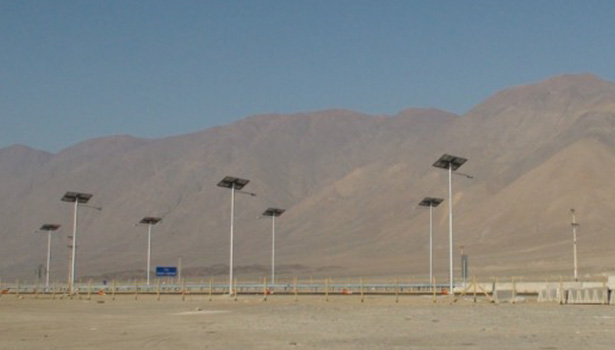
Factors to Consider When Design Solar Street Light for Desert
Design to Cope With Temperature Difference
In order to cope with the extreme temperature difference in the desert area, solar street light for desert needs to give special consideration to heat dissipation in material selection and structure design. Adopting high-strength aluminum profile as the street light shell is an effective solution. Aluminum profiles have good thermal conductivity and can quickly dissipate the heat generated inside the street light to the outside world. At the same time, the unique heat sink design can further increase the heat dissipation area, improve the heat dissipation efficiency, and prevent the street light from being damaged due to overheating.
In terms of light source selection, high efficiency LED chips should be used. High-quality LED chips not only have high luminous efficiency, which can reach more than 160lm/W, but also have good thermal stability and heat dissipation performance. They can maintain a stable working condition in a high temperature environment, reduce the light decay caused by the rising temperature, and extend the service life of the street light.
The Solution to Sand and Dust
In order to cope with the impact of sand and dust on solar panels, self-cleaning system becomes the key design. Such a system usually operates automatically through a built-in intelligent control module. It typically operates twice a day for about 3 minutes and consumes only 0.5Wh of power. The principle of operation is to remove sand and dust from the surface of the solar panels through mechanical vibration, air blowing or special coatings to ensure that the solar panels always maintain a high power generation efficiency.
In addition to the self-cleaning system, regular manual cleaning is also a necessary complementary measure. It is recommended to carry out a comprehensive manual cleaning of solar street lights every 3 - 4 months, focusing on cleaning solar panels, lamps and controllers and other components, to remove stubborn sand and dirt in a timely manner to ensure the normal operation of street lights.
There is a solar street light applied in a desert scenic area, equipped with an advanced self-cleaning system. The system utilizes ultrasonic vibration technology to efficiently shake off sand and dust from the surface of the solar panel. At the same time, combined with a special hydrophobic and oleophobic coating, it makes it more difficult for sand and dust to adhere to the solar panel. After long-term use and monitoring, the power generation efficiency of its solar panels has always been maintained at a high level, providing a reliable guarantee for night lighting in scenic spots.
Structural Design to Withstand Sandstorms
In order to withstand the impact of sandstorms, the foundation and structure of solar street lights must have sufficient strength and stability. The concrete base of the street light should be buried deep in the ground, generally at a depth of 1.5 meters - 2 meters or more, and reinforced by steel bars to ensure that the street light foundation will not loosen in the case of quicksand movement.
The material of the pole and bracket should be made of high-strength steel with anti-corrosion treatment, such as hot-dip galvanizing and spraying anti-corrosion coating, in order to improve its wind resistance and sand impact resistance. At the same time, in the structural design, streamlined design should be used to reduce wind resistance, and through reasonable mechanical calculations to ensure that the street light can remain stable under the action of strong winds, without tilting or collapsing.
Configuration for Extreme Weather
In terms of battery selection, lithium iron phosphate batteries are ideal for solar streetlights in desert areas. This type of battery has a wide temperature operating range, and can work normally under the environment of - 20℃ - +60℃, adapting to the extreme temperature conditions in desert areas. Compared with traditional lead-acid batteries, lithium iron phosphate batteries are more stable in high temperature environments and do not suffer from rapid capacity degradation and shortened lifespan due to high temperatures.
In addition, the uniquely designed smart energy pack is also an important measure to cope with extreme weather. Intelligent energy pack adopts highly efficient heat dissipation materials and reasonable heat dissipation structure, which can quickly transfer the heat generated by the battery and electronic components, so that the internal temperature of the street light rises by only 5 - 8℃ in high temperature environment, which effectively protects the normal operation of the internal components of the street light.
Some customized solar street lights for desert areas adopt advanced lithium iron phosphate batteries with self-developed intelligent energy packs. In the high-temperature test, even if the ambient temperature reaches 60℃, the temperature of the battery and electronic components can be effectively controlled, which ensures the normal operation of the street light in extremely hot weather and shows excellent adaptability.
Energy Saving and Intelligent Control
In order to improve the energy utilization efficiency of desert solar street lights, energy-saving design is crucial. The application of motion sensors can realize intelligent lighting for streetlights. When people or vehicles are detected passing by, the streetlight automatically lights up at full power to provide sufficient illumination; when no one passes by, the streetlight automatically dims to reduce energy consumption. In addition, solar powered street lights can be equipped with dimming functions to automatically adjust brightness according to different time periods. For example, when there are fewer pedestrians and vehicles in the latter part of the night, the brightness is automatically reduced to further save energy.
The intelligent control system is the core component of the solar street light. Through the built-in patented intelligent control module, users can remotely monitor the working status of solar panels, batteries, controllers and LED lights in real time, so as to detect and solve the faults in time. At the same time, the system can also automatically adjust the working mode of the street light according to the local weather and sunshine data to achieve the best energy efficiency.
In the Atacama Desert region of Chile, a solar-powered street light retrofit project was implemented. The project adopts an advanced intelligent control system, which realizes remote single-lamp control, software group control and gateway group control through wireless technology. At the same time, the system is able to collect the status of the solar system equipment in real time, issue equipment failure alarms in a timely manner, and customize the local timer on/off strategy and energy saving strategy according to the local light and usage conditions, which greatly improves the energy utilization efficiency and management convenience of the street lights.
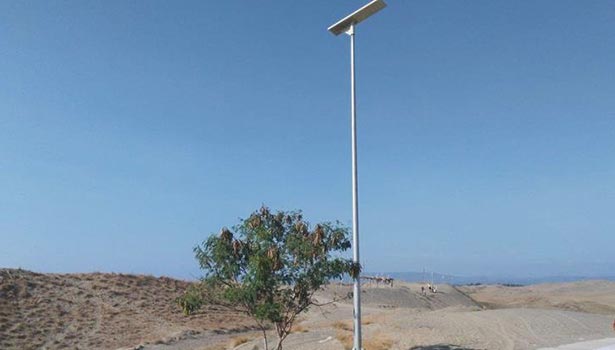
Installation Precautions for Desert Solar Street Lights
Angle of Solar Panel and Bracket Setting
The mounting angle and bracket design of solar panels directly affect their power generation efficiency. In desert areas, in order to enable the sand to slide down smoothly, solar panels should be installed at a larger tilt angle, generally recommended between 30° - 45°. At the same time, equipped with strong large-size bracket to ensure that the solar panels remain stable under the impact of wind and sand. In addition, the solar panels should be installed at an appropriate height to avoid secondary pollution from ground sand and to ensure good lighting conditions. Its orientation should be as far as possible towards the south (northern hemisphere) to get the most solar radiation energy.
Installation Points of Street Light Pole
Installation of solar street light pole is the key link to ensure the stability of desert solar street light. In desert areas, due to the problem of quicksand, the foundation of the street light pole must be specially treated. First of all, dig a pit of sufficient depth and size, put the concrete base more than 1.5 meters deep into the ground, and pre-embedded steel reinforcement in the base to enhance its bonding force with the surrounding sand. When pouring concrete, to ensure that the vibration is dense, to ensure the strength and stability of the base.
After the installation of the desert solar street light pole is completed, the level should be calibrated accurately to ensure that the pole is vertical. At the same time, fill the area around the light pole with compacted sand or gravel to further fix the pole and prevent it from moving due to sand shifting. In addition, a windproof cable can be installed at the bottom of the light pole to enhance its wind resistance.
Battery Protection Installation
Battery is an important energy storage component of solar street light for desert, which must be properly installed and protected in the desert area. Due to the extremely high daytime temperature in the desert area, in order to avoid the battery being affected by high temperature, the battery box should be buried deep underground, generally at a depth of about 1 meter. At the same time, the battery box should have good sealing and waterproof performance to prevent sand and rain from entering.
Inside the battery box, temperature sensors and ventilation devices should be installed to monitor the battery temperature in real time and automatically start the ventilation system to reduce the battery temperature when the temperature is too high. In addition, heat-insulating materials can be filled around the battery box to further reduce the impact of external temperature on the battery and ensure that the battery works in a suitable temperature environment.
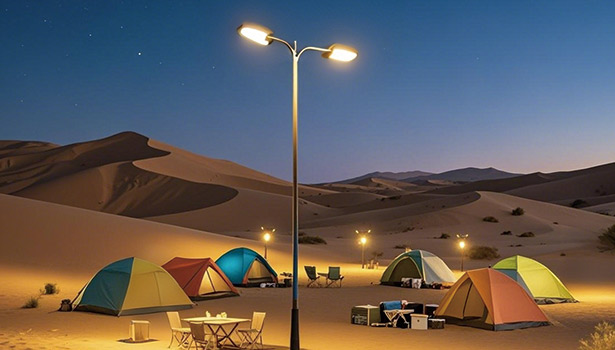
Conclusion
Designing a solar street light suitable for desert areas requires comprehensive consideration of the extreme temperature difference, sand, dust, sandstorms, extreme weather and other special environmental factors in desert areas. From material selection, structural design, functional configuration to installation and construction, each link is crucial. By adopting a series of measures such as high-strength heat dissipation materials, self-cleaning system, sturdy infrastructure, high-performance batteries and intelligent control system, the adaptability and reliability of solar streetlights in desert areas can be effectively improved.
Numerous actual cases have also fully proved that reasonably designed solar streetlights can operate well in desert areas. Such as Ningxia Shapotou area installed solar LED street lamps, not only to meet the lighting needs of the tourist areas, and the local natural scenery in harmony, but also saves the cost of laying cables, making full use of the local rich solar energy resources.
With the continuous progress of science and technology, the design and manufacturing technology of solar street light is also developing continuously. In the future, we have reason to believe that there will be more advanced technologies and materials used in the design of solar street lights in desert areas, so that they can better meet the lighting needs of desert areas and provide reliable support for the development and construction of desert areas.

